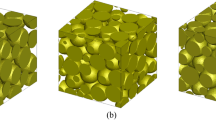Abstract
Direct measurements of the aggregation rates of natural particles can help to explain the behaviour of material suspended in natural waters, and are a stringent test of predictions from model studies. The iron oxide which accumulates each summer in Esthwaite Water in Cumbria, UK is a natural colloid consisting of a sufficiently homogeneous population of particles to allow such direct measurements to be made. Here we show that, at initial particle concentrations (n0) characteristic of those in the lake (1010–1011 dm−3), the colloid stability of the iron oxide is governed by the opposing forces of van der Waals' attraction and electrostatic repulsion, as predicted from model experiments on synthetic haematite particles coated with aquatic humic substances. However, at higher particle concentrations and with Ca2+ concentrations greater than 0.01 mol dm−3 it is found that the aggregation rate constant depends on n0, possibly indicating the participation of bridging flocculation in the aggregation process under these conditions.
This is a preview of subscription content, access via your institution
Access options
Subscribe to this journal
Receive 51 print issues and online access
$199.00 per year
only $3.90 per issue
Buy this article
- Purchase on Springer Link
- Instant access to full article PDF
Prices may be subject to local taxes which are calculated during checkout
Similar content being viewed by others
References
Lerman, A. Geochemical Processes (Wiley, New York, 1979).
Yariv, S. & Cross, H. Geochemistry of Colloid Systems (Springer, Berlin, 1979).
Stumm, W. & Morgan, J. J. Aquatic Chemistry 2nd edn (Wiley, New York, 1981).
Hunter, K. A. & Liss, P. S. Nature 282, 823–825 (1979).
Edzwald, J. K., Upchurch, J. B. & O'Melia, C. R. Envir. Sci. Technol. 8, 58–63 (1974).
Hahn, H. H. & Eppler, B. in Colloid and Interface Science Vol. 4 (ed. Kerker, M.) 125–137 (Academic, New York, 1976).
Hunt, J. R. Envir. Sci. Technol. 16, 303–309 (1982).
Tipping, E. & Higgins, D. C. Colloid Surf. 5, 85–92 (1982).
Sholkovitz, E. R. Geochim. cosmochim. Acta 40, 831–845 (1976).
Mayer, L. M. Geochim. cosmochim. Acta 46, 2527–2535 (1982).
Mortimer, C. H. J. Ecol. 29, 280–329 (1941); 30, 147–201 (1942).
Davison, W., Heaney, S. I., Talling, J. F. & Rigg, E. Schweitz. Z. Hydrol. 42, 196–224 (1981).
Tipping, E., Cook, D. & Woof, C. Geochim. cosmochim. Acta 45, 1411–1419 (1981).
Tipping, E. Geochim. cosmochim. Acta 45, 191–199 (1981).
Tipping, E. & Cooke, D. Geochim. cosmochim. Acta 46, 75–80 (1982).
Tipping, E. Chem. Geol. 33, 81–89 (1981).
Matijevic, E. & Scheiner, P. J. Colloid Interface Sci. 63, 509–524 (1978).
Von Smoluchowski, M. Z. phys. Chem. 92, 129–168 (1918).
O'Melia, C. R. Envir. Sci. Technol. 14, 1052–1060 (1980).
Tipping, E. & Heaton, M. J. Geochim. cosmochim. Acta 47, 1393–1397 (1983).
Spielman, L. A. J. Colloid Interface Sci. 33, 562–571 (1970).
Hatton, W., McFadyen, P. & Smith, A. L. JCS Faraday 70, 655–660 (1974).
Overbeek, J. T. G. in Colloid Science Vol. 1 (ed. Kruyt, H. R.) 302–341 (Elsevier, Amsterdam, 1952).
Müller, H. Kolloidchem. Beih. 26, 257–311 (1928).
Gregory, J. in The Scientific Basis of Flocculation (ed. Ives, K. J.) 101–130 (Sijthoff & Noordhoff, Alphen aan den Rijn, 1978).
Williams, D. J. A. & Ottewill, R. H. Kolloid-Z. Z. Polym. 243, 141–147 (1971).
Lindström, T. & Söremark, C. J. Colloid Interface Sci. 55, 69–72 (1976).
Van der Scheer, A., Tanke, M. A. & Smolders, C. A. Discuss. Faraday Soc. 65, 264–281 (1978).
Walles, W. E. J. Colloid Interface Sci. 27, 797–803 (1968).
Sommerauer, A., Sussman, D. L. & Stumm, W. Kolloid-Z. Z. Polym. 225, 147–154 (1968).
Busch, P. L. & Stumm, W. Envir. Sci. Technol. 2, 49–53 (1968).
Eaton, A. Est. Coast. mar. Sci. 9, 41–49 (1979).
Massalaski, A. & Leppard, G. G. J. Fish. Res. Bd Can. 36, 906–921 (1979).
Author information
Authors and Affiliations
Rights and permissions
About this article
Cite this article
Tipping, E., Ohnstad, M. Colloid stability of iron oxide particles from a freshwater lake. Nature 308, 266–268 (1984). https://doi.org/10.1038/308266a0
Received:
Accepted:
Issue Date:
DOI: https://doi.org/10.1038/308266a0
This article is cited by
-
The Role of Macrophytes in Constructed Surface-flow Wetlands for Mine Water Treatment: A Review
Mine Water and the Environment (2021)
-
Facile One-pot Transformation of Iron Oxides from Fe2O3 Nanoparticles to Nanostructured Fe3O4@C Core-Shell Composites via Combustion Waves
Scientific Reports (2016)
-
Aggregation of montmorillonite and organic matter in aqueous media containing artificial seawater
Geochemical Transactions (2009)
-
Nanoparticles: structure, properties, preparation and behaviour in environmental media
Ecotoxicology (2008)
-
Natural and man-caused factors affecting the abundance and cycling of dissolved organic substances in precambrian shield lakes
Hydrobiologia (1992)
Comments
By submitting a comment you agree to abide by our Terms and Community Guidelines. If you find something abusive or that does not comply with our terms or guidelines please flag it as inappropriate.



